Insect pest of Ber in Hot Arid Region
Insect pest of Ber in Hot Arid Region
Ber fruit fly (Carpomyia vesuviana)
- This fruit fly is the most destructive pest of ber.
- It is a monophagous pest that infests only on Zizyphus species growing under arid and semi arid region in India and also in Oriental Asia, Middle East, Temperate Asia, China and South Europe.
- It contributes towards low yield and poor quality of fruits and causes yield loss upto 80% under severe infestation.
Host Range
- Ber (Zizyphus mauritiana, Z. numularia, Z. rotundifolia)
Nature of Damage
- The maggots start infestation with the onset of fruit setting.
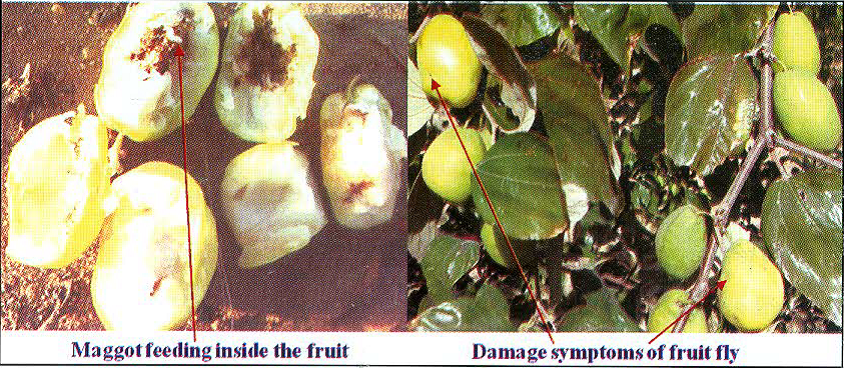
- The fly lays eggs singly in the young developing fruits.
- After 2 to 5 days the newly hatched maggot’s starts feeding on the pulp and make galleries with accumulated excreta and result in rotting of fruits.
- The larva burrow the flesh round the centre leaving excreta that give fruits a bitter taste.
- In arid region, the infestation starts from end of September and the higher incidence is during December-January.
Description:
- The fruit fly is easily distinguished in having distinctive pattern of black marks on the scutum and scutellum, and distinct yellow and brown bands on the wings.
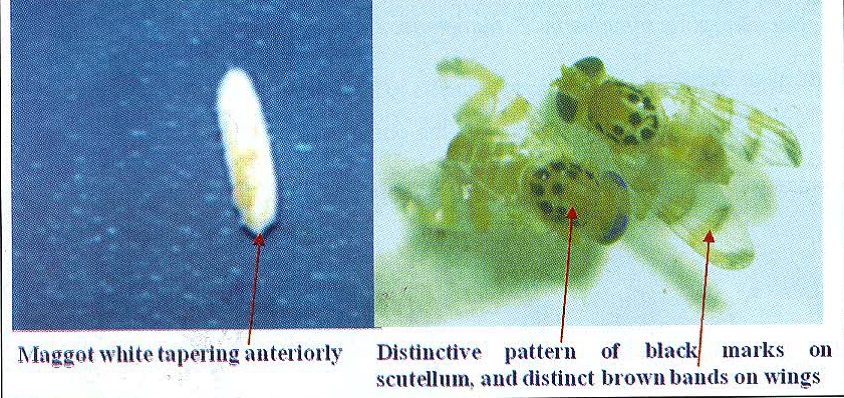
- Two to three generations are completed from November to April.
- Eggs are laid in cavities made on the fruit with the ovipositor.
- The punctures appear as black spots in depression later on.
- Maggots bore into the pulp forming reddish brown galleries.
- The full grown maggot falls to ground to pupate in soil 5 to 7.5 cm deep for periods varying from 14 to 300 days depending upon the climate.
Management
The fruit fly cause internal damage, preventive measures are essential and synthetic insecticides are major tools for the successful management. However, integrated approaches would give better control over single control approach with low cost and environmentally safe.
- Clean cultivation surrounding the orchard through destruction of pruned parts of cultivated as well as the wild bushes.
- Collection of all fallen, bird damaged and infested fruits at periodical interval and proper destruction and feed such fruits to sheep goats, camels or other farm animals or bury them at least on one meter deep in compact soil can avoid the fly’s emergence.
- Deep and through racking up of soil during hot summer to expose the residual pupa to hot summer it also been destroy the over wintering pupae through mechanical injury during the operations.
- Use of resistance varieties like Tikadi, Katha and Illaichi for fruit fly management.
- There is no successful record of parasitoids, predators and pathogens against the C. vesuviana. The braconid, Biostres vandenboschi, Bracon fletcheri and Omphalia sp. on ber fruitfly were reported. The wasp parasitoid, Fopius carpomyia was found at larval stage of fruitfly and the ovipositor is very suitable to parasitize the hidden host in fruits. The rate of parasitization was upto 28.8% under natural condition.
- The extract of azadiractin 1% and Ocimum sanctum 1% were effective up to 10 days after spraying. Application of neem powder and tobacco leaf extracts would also significantly reduce C. vesuviana damage and its used for organic cultivation of ber.
- Bait spray combining molasses or jaggery 10 g/L and one of the insecticides, malathion 50 EC 2 ml/L, dimethoate 30 EC 2ml/L of two rounds at fortnight interval before ripening of the fruits.
Ber stone weevil (Aubeus himalayanus)
- Ber stone weevil, Aubeus himalayanus was recorded as a new pest of ber for the first time from Karnataka state of India in 1993.
Host Range
- Ber
Nature of Damage
- When damaged fruits are cut open, the developing seed is completely eaten away by the pest.
- In the hollowed area, each of these fruits have a grub, a pupa or an adult which is identified as ber seed weevil.
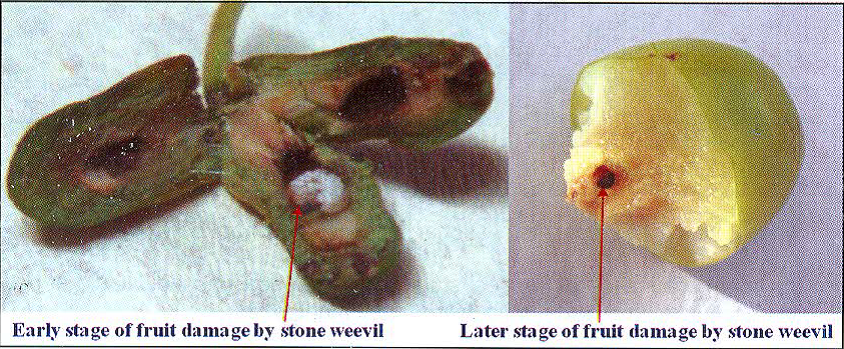
- The infested fruits are round in shape and varied in size ranging from pea to pebble.
- The fruits do not attain maturity and never increase in size more than pebble.
Description
- Black colour egg laid with marking in the stylar end of fruits.
- Mouth parts are converted into snout.
- The grubs are white in color.
- The adult is blackish color with abdomen rounded.
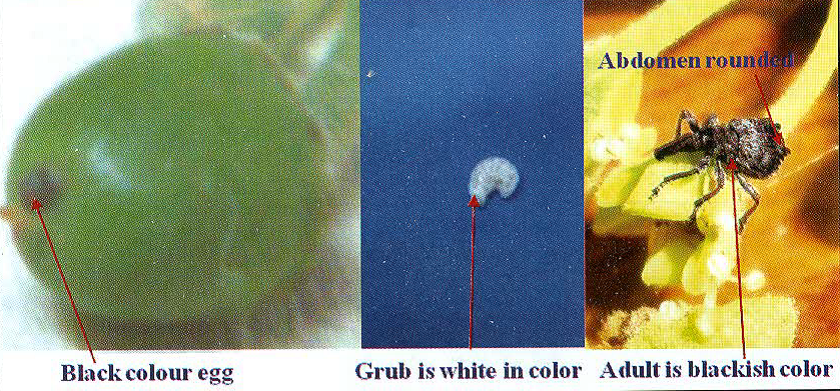
- Seasonal occurrence of the pest studied over two seasons indicate that only one peak is observed during July-August months.
Management
- Collection and destruction of adult weevil immediately after detection can also reduce the population. Infested dropped fruits should be collected and burned to break the generation cycle.
- Deep and through racking up of soil during hot summer to expose the residual adult to hot summer, it also been destroy the over wintering adult through mechanical injury during the operations.
- The influence of biophysical factors of ber fruits plays a major role on the intensity of damage by ber stone weevil. The varieties of ber like Kali, Katha, Illaichi and Tikadi were found resistant to stone weevil. The fruit infestation ranged from 9.02 to 49.88 % on retained fruits and 13.57 to 74.16% on drooped fruits. Tannins, phenols, alkaloids and flavonoid contents had significant negative correlations with the percentage fruit infestation on plant fruits and the fallen fruits. The highest pulp: stone ratio was found in variety Mundia and least in variety Tikadi. Most of the resistant varieties were having extremely hardy stones and in susceptible varieties the stones were slightly hard.
- NSKE 5% and azadirachtin 2000ppm and 1000ppm were also found to be superior over control treatment in minimizing the weevil incidence.
- Application of spinosad 2.5 SC and indoxacarb 14.5 EC or dimethoate 30 EC just before the fruit setting and repeat the sprays at three weeks interval was found effective and showed significant reduction in weevil incidence.
Ber butterfly (Tarucus theophrastus)
- It is found in Northern and Western Africa, Arabia, Persia, Baluchistan, N.W. Himalayas, Assam, Punjab, Western, Central and Southern India, Srilanka and Upper Burma.
Host Range
- Ber
Nature of Damage
- The ber trees are always severely pruned during May-June and the newly sprouting tender shoots and leaves are attacked by ber butterfly.
- Due to its attack, the leaves dry up and tender shoots do not grow properly.
- Larvae feed on sprouting tender shoots, leaves and flower buds. Infested leaves gives whitish look due to feeding of chlorophyll and finally the leaves remain with long streaks.
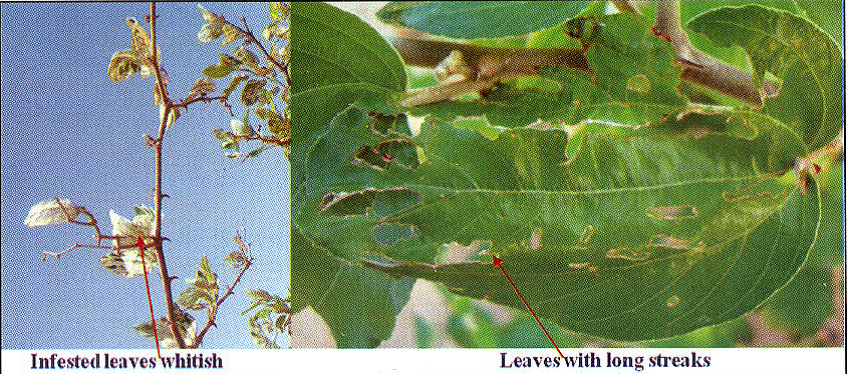
Description
- Female upper side: dark brown; bases of the wings suffused with bluish scales.
- Fore wing: the transverse discocellular spot continues posteriorly by a black spot in interspace to coalescent with a similar spot.
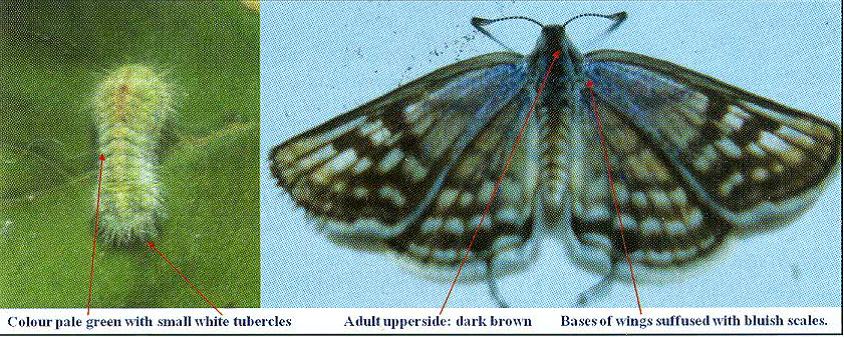
- The larva just half an inch in length when full grown, is much flattened, the head is pale ochreous and completely hidden under the second segment.
- Colour pale green, the whole upper surface is covered with a shagreening of small white tubercles.
Management
- Spray of dimethoate 0.05%, deltamethrin 0.0014% and fenvalerate 0.0005% would be most effective against 3rd to 6th instar larvae.
- Quinalphos (0.05%) and triazophos (0.1%) were also effective against larval population and leaves damage.
Ber fruit borer (Meridarchis scyrodes)
- It is distributed all over the country. It is not a major pest of Bikaner area but it is major in Sirohi, Jalore, Barmer districts of Rajasthan and Gujarat.
Host
- It is a polyphagous pest and feeds on crops like ber, aonla etc.
Nature of Damage
- The larva bores into the fruit feeding on the pulp and accumulating faecal frass within.
- Up to 40% of the fruits are damaged during July and August.
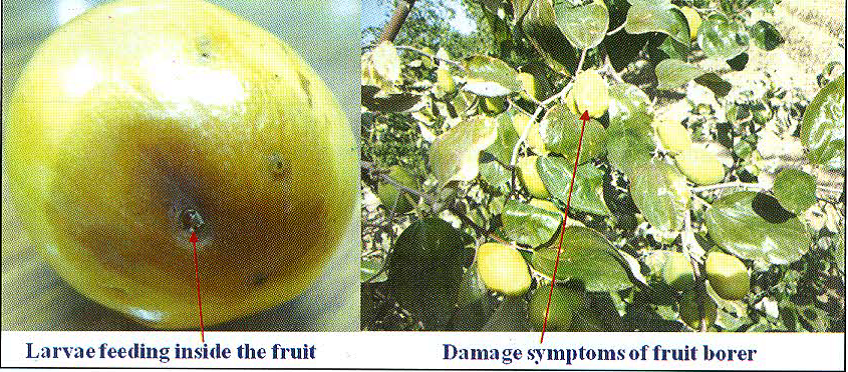
Description
- Adult is a small dark brown moth. Eggs are laid on young fruits.
- Early instar larva is light yellowish and full-grown larva is red in colour.
- Pupation takes place in the soil.
- Adult emerges from the soil.
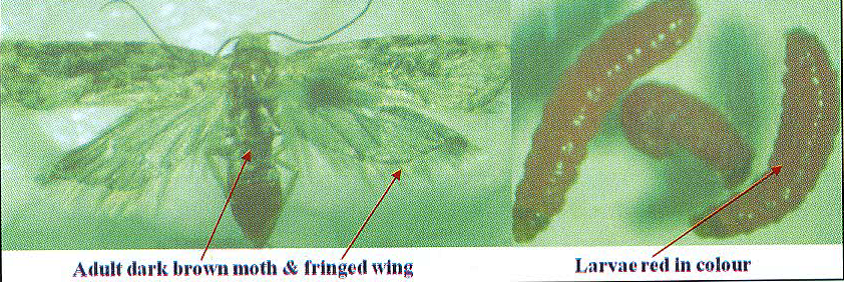
- Removal of wild ber trees around the ber orchard.
- Rack the soil under the tree or near the trees to destroy the maggots and residual pupae present in the soil.
- Collection and proper destruction of infested fallen fruits. Harvest of fruits at immediate after maturity (green stage).
- Growing of resistant cultivars like Safeda, Illaichi and Tikadi to found less incidence of fruit borer.
- The Neem Seed Kernel Extract (NSKE) at 5% found as effective as like synthetic chemicals. Methanol extracts of Annona reticulata, Azadirachta indica and Ocimum sanctum at 1% concentration recorded 60-70 % mortality after 48h after spray.
- Sprays of dimethoate 30 EC + jaggery solution (1.0%) at marble stage and one spray at maturation stage resulted in minimum infestation and found to be more economical. Control schedule comprises of malathion at 2 ml or fenvalerate at 1 ml /lit of water first spray at marble stage, second spray at 15 days later and third spray at fruit ripening stage by alternate use of insecticides would be effective against the fruit borer
Bark eating caterpillar (Indarbela quadrinotata)
- It is found worldwide. In India it is found in Tamil Nadu, Odisha, Maharashtra, Rajasthan, Gujarat etc.
Host Range
- It is a polyphagous pest and feeds on ber, aonla, mango, citrus etc.
Nature of Damage
- The freshly hatched larvae feed on the surface of tree trunks.
- It makes winding galleries of frassy web on the stem near the forks and angles of branches.
- When strong enough, they bore inside the trunks and move about inside the concealed silken gallery and feed on the bark by scraping which interrupts the translocation of cell sap and adversely affecting growth and fruit setting capacity of the tree.
- Ribbon like or pipe like webbings on the stem near forks or angles of branches and the tree trunk is the clear indication of its damage.
- The caterpillar is hidden-in the stem in the day-time and becomes active at night, eating the bark.
- Heavy infestation by this pest stunts the trees and adversely affects fruit yield.
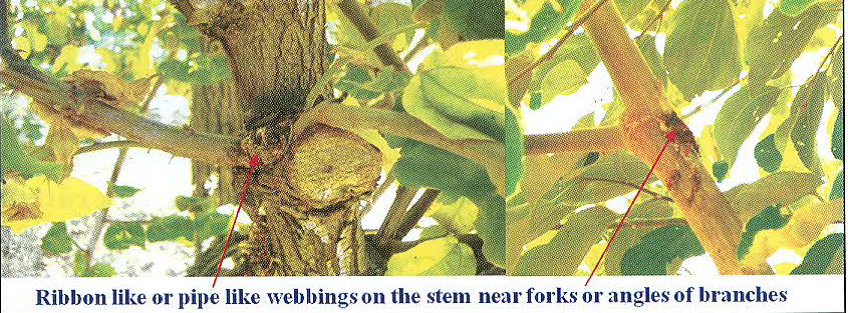
Description
- The female moths are pale brownish with forewings having row of dark rusty red spots. In females, abdomen has a tuft of hairs at its tip.
- Males, length varies from 22- 25 mm while in females 32-34 mm.
- It lays eggs with the onset of the rainy season in batches of 15 to 25.
- After emerging, the caterpillars start devouring the bark. The caterpillars pupate during the summer for about four weeks and from the pupae adult moths emerge, mate, and lay eggs again.
- Only one caterpillar is seen in a gallery.
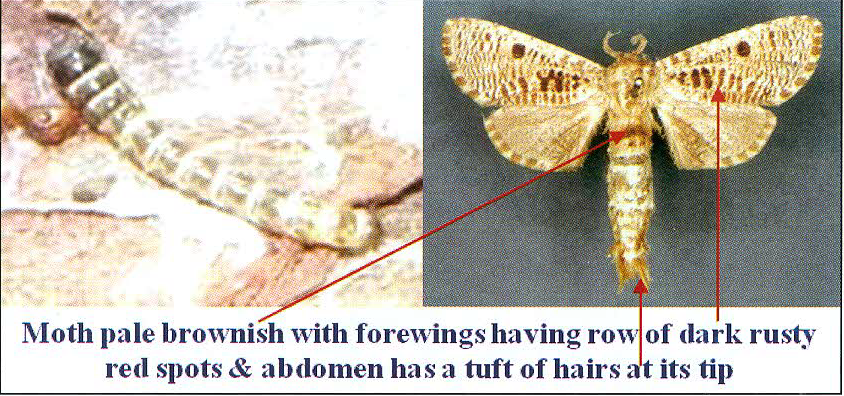
- Periodical cleaning of orchard and removal of webs/frassy galleries around affected portion at the time of pruning and destruction of caterpillar using iron spike in hole.
- The cultivars such as Rothak Gola, Laddu Glory, Chuhhara and Desi Alwar are found to be tolerant to bark eating caterpillar. However no cultivars found to be resistant.
- Painting of dimethoate 0.05% on the bark would be effective. Application of kerosene mix contains one litre of kerosene and 100g of soap in 9 litre of water to the holes has been found to be effective against caterpillar.
- Inject the holes with quinalphos at 0.01% or fenvalerate at 0.05% and alternate spray of quinalphos at 2ml per litre water of found to be effective in controlling the caterpillar damage. Cotton swab soaked in petrol or kerosene also can place in the holes and sealed with mud.
Ber weevil
- Ber weevil, Myllocerus dentifer, M. blandus & Amblyrrhinus poricollis are minor pests of ber.
Host Range
- lt is a polyphagous pest but majorly occurring in ber.
Nature of Damage
- The adult beetles feed on leaves of ber.
- Damage can range from notching on the leaf margins to much more extensive feeding along the leaf veins.
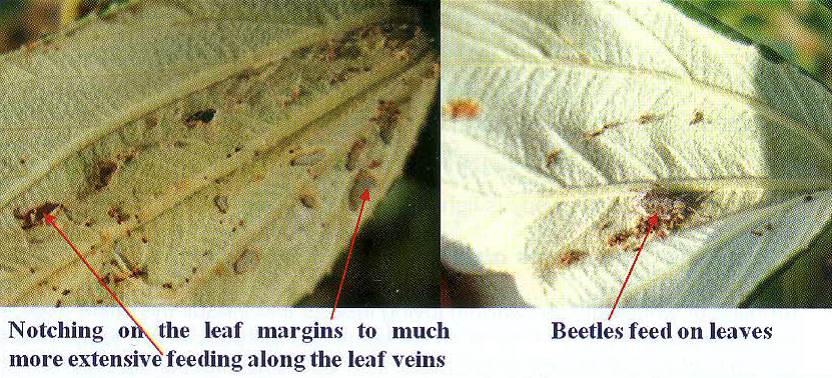
Description
- Adults lay their eggs in the soil.
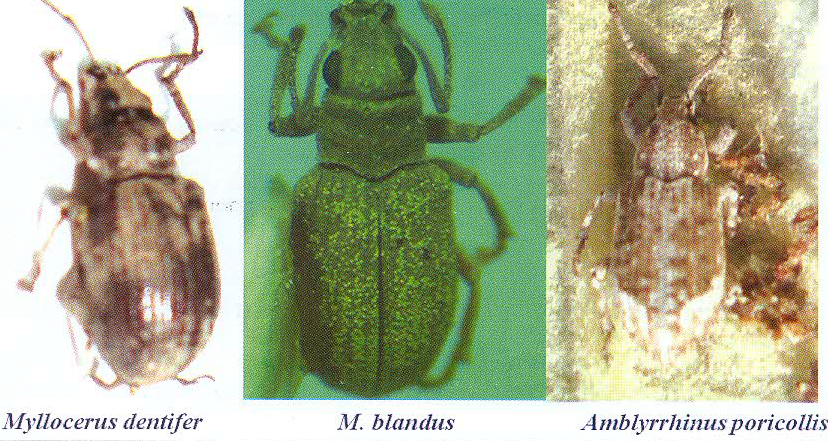
- Larvae are small, creamy white, and legless. They are root feeders.
- Adults can cause severe feeding damage to the foliage.
- Myllocerus dentifer body is blackish in color with brownish spots. M. blandus body is dark brown in color. Amblyrrhinus poricollis body is light brown in color with whitish strips on body.
Termite (Odontotermes obesus)
- Termites or white ants are warmth loving insects and inhabit the entire tropical and subtropical regions of the world except higher altitudes where temperature is too low and the deserts where there is no food. They devour not only the live plant material but also the dead wood.
Host Range
- They are polyphagous and have the widest range of host plants like ber, aonla, date palm, pomegranate, lasora, phalsa etc.
Nature of damage
- Termites attack wheat and barley from the time of sowing onwards and the damage is severe in sandy and sandy-loam soils.
- lt cannot thrive under conditions of bad aeration and poor drainage.
- The damage may vary from 40 - 50%.
- The internal part of plants are eaten away up to 1-2 feet height of stem and filled with earth.
- Termites also appear and cause havoc in orchards that have been raised on virgin lands.
- The damage is more severe in nurseries and young newly planted orchards where the entire seedlings or saplings may dry and die away.
Description
- The termites are heliphobic and either remains underground and feed on roots and then move upwards making the trunks completely hollow or they construct mud galleries on tree trunks.
- Formation of earthen galleries on tree trunks decreases with rise in temperature from March onwards and it again increases from September onwards.
- These different functionaries constitute well-defined castes like the soldier caste, the worker caste, the reproductive caste and the royalty.

- The queen is the largest individual, the size of which at times exceeds five centimetres in length and one centimetre in thickness due to the enlargement of the abdomen which is full of eggs.
- The rest of the colony consists of the king, the functional consort of the queen, three sub-castes of fertile reproductives and two sterile castes of workers and soldiers.
- The sterile castes the workers, which constitute the main labour force of the colony, have undergone reduction in brain and eye development.
- Winged sexual forms appear with the first shower of monsoon.
- The mating takes place either up in the air or on the ground and soon after mating the insects lose their wings, re-enter the soil and start a new colony.
- The Queen lays one egg every 2 - 3 seconds continuously during her entire life span of 7 - 10 years.
Source: Insect pests of Arid Fruit Crops
Related resources
Last Modified : 3/29/2021
This topic provides information related to steps t...
This topic explains about psychological human deve...
This topic provides about *99# Service- Innovative...
This topic covers information related to Acute res...
